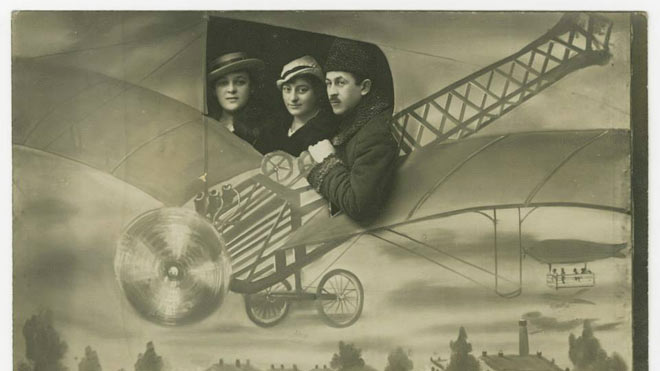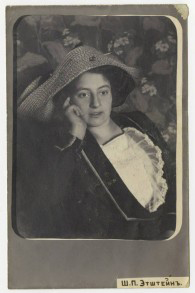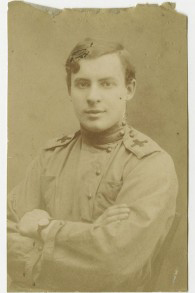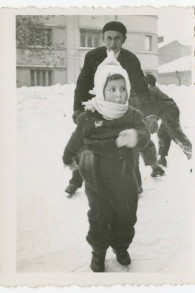We stumbled across this article shortly after publishing a piece about another Jewish family that smuggled their album out of Nazi Germany in the 1930s by Amanda Herz. Unlike Amanda’s family which was able to smuggle themselves out of the country, the Lithuanian family whose photo albums were recently discovered in a storage room in the Sugihara House museum in Kaunas, Lithuania, tragically perished in the holocaust. The piece below, published in the Times of Israel, speaks to what can we learn from this family photo album and also what is the responsibility of those who find and/or encounter it.

Anushka Warshawski, center, smuggled her photo album out of the Kovno ghetto shortly before its liquidation and her death in 1943. (Courtesy of Richard Schofield/via JTA)
NEW YORK (JTA) — When documentary photographer Richard Schofield stumbled upon a trove of unidentified prewar photographs in September 2013 in the storage room of the Sugihara House museum in Kaunas, Lithuania, he knew he had found something special. The photos, dating from about 1910 through 1940, were from the album of a Lithuanian Jewish family, which had been smuggled out of the city’s wartime Jewish ghetto and entrusted to a non-Jewish Lithuanian family for safekeeping. But nobody knew what had happened to the people in the pictures. Presumably they did not survive the war to reclaim their photos. Touched by the images and intrigued to learn what had happened to their subjects, Schofield set about trying to identify them. He scanned the 112 photos, set up a Facebook page to showcase them and commissioned a piece of music to accompany an exhibition of the photographs that would mark the 75th anniversary of the ghetto in Kaunas, then known as Kovno. Then, in late March, by a twist of serendipity, a non-Jewish archivist who worked at the Jewish museum in the Lithuanian capital of Vilnius noticed something: After clicking through the photographs and doing a bit of sleuthing, Saule Valiunaite realized that one of the photos appeared in a Holocaust documentary film made in 1999.

After a documentary photographer stumbled upon Anushka Warshawski’s photo album, it took some sleuthing to figure out who she was. (Courtesy of Richard Schofield/via JTA)
“It was a huge family, and they all died,” Roskies said. “My mother dedicated the rest of her life to keeping the memory of that family alive. She told stories about them three times a day, at breakfast, lunch and dinner. My mother believed that history ended in 1940, that everything important ended the moment she left Europe.” “These stories were like her Bible, they were the reference point for her whole subsequent life. We were constantly reminded of these people we never met and would never meet. They became our surrogate family.”

Nyonya, who died in the 1918 influenza epidemic, was a favorite brother of Anushka and her surviving sister, Masha. (Courtesy of Richard Schofield/via JTA)
The newly discovered album confirms the special bond between his mother, Masha, and Anushka, Roskies said. The two sisters (half-sisters, actually, since Masha was born to her mother’s second husband) corresponded and sent photos back and forth during the years after they married and lived apart – Anushka in Kovno and Masha in Vilna and then Czernowitz. They reunited only once during those years, in Czernowitz in 1938. After that, they never saw each other again.
Schofield, who is still recovering from the shock of the discovery, is raising money for a piece of music he’s calling the “Kaunas Requiem” that he hopes to stage at an installation in September to mark the 75th anniversary of the establishment of the Kaunas/Kovno ghetto. He’s not yet sure how he’ll incorporate the new information about the photographs.

American Yiddish scholar Ruth Wisse, here probably age 4, appearing in her aunt Anushka’s photo album. (Courtesy of Richard Schofield/via JTA)
“When I found the photographs, I thought it would be nice to put names to faces. I never really thought about what I would do if that happened,” said Schofield, a non-Jewish native of Britain who has been living in Lithuania for the past 15 years and says he is endlessly fascinated by the vanished Jewish past of his adopted city. “It’s all pretty incredible, really. It’s been a bit of a roller coaster.”
The fact that Anushka went to the trouble of smuggling the album out of the Kovno ghetto speaks volumes, Roskies said. By the time of the ghetto’s liquidation, in 1943, it must have been clear to the Jews who remained that they, too, soon would be headed to their deaths, Roskies surmises. “Why would Anushka care about a photo album if she was going to die?” Roskies asked. “She knew Masha had escaped to Canada and survived. What must have been going through Anushka’s head was: ‘We reached the end of the line. The ghettos are being depleted. I want Masha to have this album, so I have to find a way of getting it to her.’”
Visit the website to see the whole story!
No comments yet.